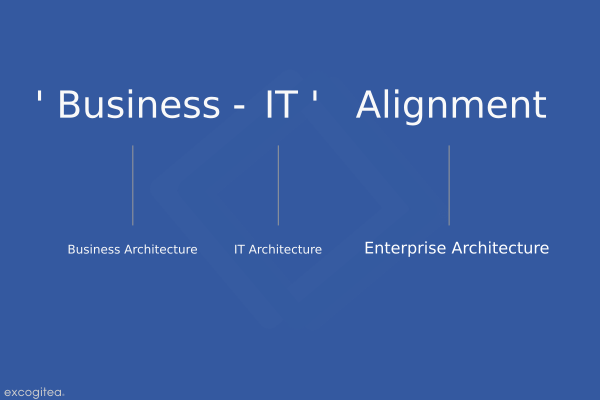
Let’s not remind that Enterprise Architecture isn’t IT Architecture.
And this is not only a matter of naming !
Maybe that it wouldn’t have been an issue if Enterprise Architecture meaning wasn’t referring to another foundational scope.
The image already says a lot. However, let’s add some comments.
Business and IT are different domains, not only by naming but by essence.
They each have respective needs and they obey to design rules specific to their domain.
Their schemes are different. Yet, they need to be aligned.
This concern implies and introduces several foundational points.
Even though Business is the end-purpose, alignment is not about aligning IT to Business !
This can only end up with a business-siloed IT hampering the overall IT scheme and its efficiency.
Even though IT provides new opportunities, alignment is not about aligning Business to IT, either.
This can only end up with an IT-dependent and non-adaptable Business scheme.
Therefore, speaking of alignment, the least that can be done is to consider it both-ways.
IT can support Business activities AND Business can get new opportunities thanks to IT.
But, this can’t be achieved simply based on their respective schemes.
The overall scheme can’t be limited to that binary and confrontational opposition with a constant arbitration of one claiming that the other must align.
If we want both “working together”, we need to consider a broader context.
A context wherein Business can express its goals and IT can expose its features.
Enterprise Architecture is precisely the domain to achieve that.
Enterprise Architecture is the one for overall cohesion, and it’s not only a naming.
Rather than, or furthermore than, an arbitration authority, Enterprise Architecture is meant to define and to actually shape the overall context which integrates decoupling and correlations criteria at a generic level.
Now, in terms of Organisation Chart, …
You might have what’s called “Enterprise Architecture” under the IT branch.
In that case, you might want to assess the real activity it represents, and eventually rename it “IT Architecture” before you consider moving it under the Business branch.
As for moving “Enterprise Architecture” to the Business branch, it is surely not worse.
That said, it may be interesting to distinguish Governance from pure Business activity.
And, as Enterprise Architecture acts at a generic level and is even Business-domain agnostic, it is worth knowing that it is closer to Governance.
Precisely, Enterprise Architecture can help define the Organisation Chart so that it is not just an arbitrary administrative view.
Alignment is plural.
Enterprise Architecture takes care of the overall context, as a generic and multi-dimensional scheme.
